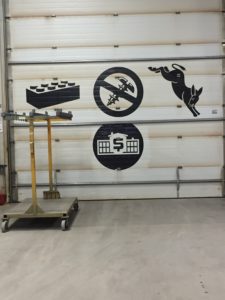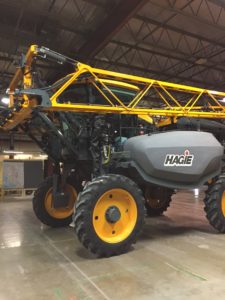5/23/17
As we were touring the Hagie Manufacturing plant early this morning, the one question that kept popping into my mind was, “Why are there so many people working here?” A few days ago, we had the opportunity to be able to tour the Frontier Coop in Norway, Iowa. During this tour, we were shown how spices were made using an assembly line, which was the type of mechanism that I figured would also be used to create a very large and powerful machine such as a Hagie Sprayer. However, to my surprise, this was not the case and almost the entire process was done by manual labor. I must reiterate that these machines were huge and I find it extremely impressive that they are able to build one of these machines per day, almost entirely manually! The manufacturing plant has around 300 workers, all of whom play an important part in the process of creating these giant pieces of equipment. Our tour guide, Clint Middleton, explained to us that on days they know they have to build a larger piece of machinery, some of the workers clock in a few hours earlier, while the remaining workers stay a few hours later than usual. I find this communication and teamwork to be satisfying, knowing that they are able to get the job done just as efficiently as an assembly line with robots, if not more efficiently.
Continuing on the topic of community in this particular cooperation, I thought it was very rewarding to see how the employees are treated on a daily basis. To begin with, every garage door inside of the building had four pictures painted on them. The first was a Lego, symbolizing the work it will take to build the company together. The second was a screw, demonstrating not to “screw over the customer”. The third was a donkey, representing the need to create “kick ass products”. Finally, the fourth was a building with money, showing the resulting image of a successful business. These images served as inspiration to the employees and reminded them on a daily, if not minutely basis to work together to achieve the common goal of being successful. I also found it interesting that the majority of the employees consisted of a younger generation (perhaps in their 30s or below). This could be due to the amount of manual labor that the job requires, or maybe the atmosphere attracts the younger generation in general. For example, the break room/dining area consisted of a tiki bar with a pool table and red solo cup decorations. I found this area of the break room to be rather amusing yet indulging to know that the employees are able to have such a strong bond with each other.

When thinking of the cost of these machines (around $400,000 per sprayer), the necessity of a successful yield truly comes into focus. These pieces of equipment cost more than my house and account for the livelihood of any farmer who chooses to buy one of these machines. I am now starting to realize why some farmers become upset at government officials for trying to regulate how much fertilizer they can spray on their own land. If I spent almost half a million dollars on a piece of equipment and then someone tried to tell me that I had to reduce my usage of this equipment on my own land, I believe that I would also fight back on this regulation. To make matters even worse for the farmers, this is only one out of the several different machines that are required to produce maximum yield. However, I do not have a solution to this problem, but I am hoping that as our final week continues, more of this issue can be put into perspective for me and my classmates.
